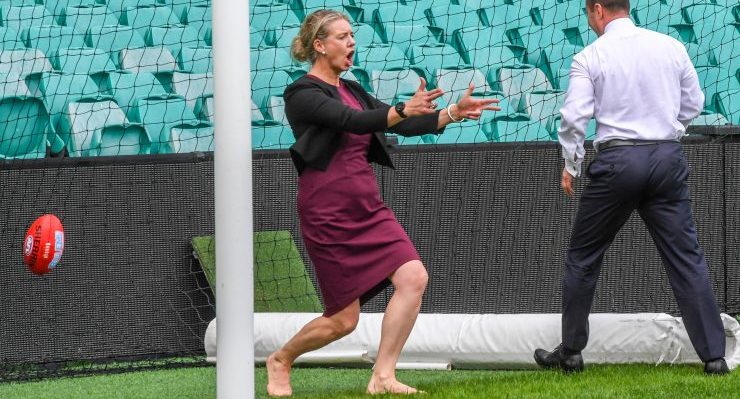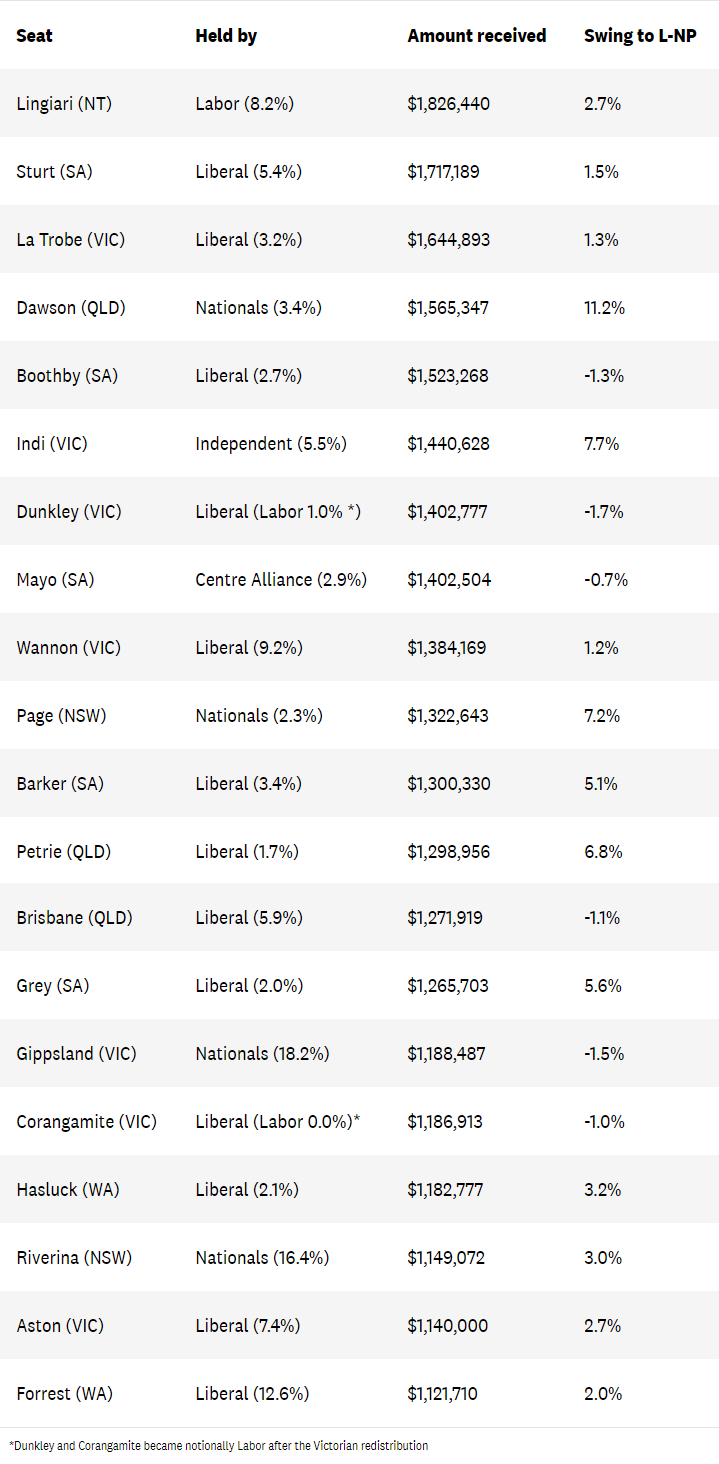
Of the many depressing features of the recent sports rorts scandal, perhaps the worst is its familiarity, given the striking parallels with the Ros Kelly whiteboard affair of the Keating government’s terminal phase in the mid-1990s.
Even allowing for the fact that standards have apparently fallen to the point where Bridget McKenzie looks likely to keep her job, one might have thought the Kelly precedent would have given McKenzie pause for thought as she oversaw the allocation of $100 million in a manner transparently tailored to boost the Coalition’s electoral prospects.
Her failure to do so offers a telling insight into how much political operators imagine they have to gain by enticing voters with expensive baubles.
Given the government’s success in winning a third term when it appeared to have so much going against it, it may be tempting to reach the disheartening conclusion that this outlook has been vindicated.
However, when the election result is analysed in detail, scant evidence emerges that McKenzie’s efforts did the Coalition any good at all.
At issue is the distribution of 684 grants out of the Community Sports Infrastructure fund, around two-thirds of which was allocated to specific clubs and local projects, with most of the rest going to local councils.
The table below accounts for the 20 electorates that did best out of the bargain, and provides as clear an indication as any of the lack of subtlety with which McKenzie went about her work.
Lest anyone think the program was all bad, grants targeting Indigenous communities lifted the Northern Territory seat of Lingiari to the top of the pile, despite it being a long shot proposition for the Coalition at the election.
After that though, the list is a clean sweep of conservative seats, including two the Liberals were hoping to win back from crossbenchers (one being Mayo, where the trouble all began).
Almost all were of the highest strategic importance, being on margins below the Australian Electoral Commission’s 6% threshold for designating a seat as marginal (including Corangamite and Dunkley, which were held by the Liberals but notionally Labor after the Victorian redistribution).
The exceptions at the upper end tended to be held by the Nationals, perhaps for the reasons noted here yesterday by Bernard Keane.
Comparison with the opposite extreme is instructive — the 20 seats that received the least amount of funding consisted of four the Coalition knew they wouldn’t lose, and 16 they knew they couldn’t win.
Did the sports rorts make a difference?

At first glance, it might be thought that the sports grant pork-barrel landed a few successes, with the average Coalition swing of 2.8% out of the top 20 comparing with a national result of 1.2%.
However, this is inflated by a couple of outliers: the north coast New South Wales seat of Page, where Nationals member Kevin Hogan enjoyed the second biggest Coalition swing in the state after Joel Fitzgibbon’s near-death experience in Hunter, and the north Queensland seat of Dawson, where George Christensen defied every political maxim going to pick up the second biggest swing in the country.
In country seats especially, electoral effects of sports club grants should be highly localised — and the deeper one burrows into the data, the harder it gets to discern any such effect.
When polling booth and sport grants data are aggregated into 2288 local regions designated by the Australian Bureau of Statistics, there turns out to be no correlation whatsoever between the amount of funding they received and how much they swung to or against the Coalition.
This should not actually come as a surprise, since the Coalition owed its win not to fortuitous patterns of voting in decisive seats, but to a 51.5% share of the national two-party vote.
In other words, this was an election won at the macro rather than the micro level — in particular, by the force of Scott Morrison’s adroit sloganeering against an unpopular opponent encumbered by an over-ambitious agenda.
As such, the sports grants affair stands testament not just to the deviousness of much of the political class, but also to its egotism in imagining that elections hinge upon ultimately inconsequential tactical manoeuvres cooked up in ministerial offices.








Any one still wondering ‘just how rank’ these rank amateurs are?
Behind in the polls – they thought they had to do something. What’s more Coal-ition than pork-barreling?
….. Reckon McKenzie wouldn’t have been half pleased on election night?
Who was the Coal-ition candidate in Lingiari?
Jacinta Price – seen behind Morrison in every photo-op when he was up there during the campaign?
Maybe they saw it as a “gamble worth taking”? After all it’s not as though it was their money they were plunging.
So the Government contributed to the widespread disillusionment with politics and politicians and outed itself as dishonest and lacking in integrity all for no measurable electoral gain. Then the Prime Minister crept away to Hawaii (How good is Australia! Where the ****** are ya? ) leaving his office to actually lie about where he was while a national catastrophe was spreading and now says, ” If I’d known then what I know now I’d have done things differently.” I thought we’d got rid of something bad in our nation when Howard was defeated. Howard himself must be shaking his head at this bunch.
He’d be nodding in approval.
Can’t elevate Honest John above any political skulduggery.
From non-core promises -> knifing the “too fair” Bob Halverson (his own Speaker) -> Children Overboard -> Iraq/WMDs -> to the buggery of East Timor -> AWH/NPA.
He set the bar so low only he could limbo under it.
The Guardian is reporting that sports grants were allocated to other wealthy sports clubs for things like installing lifts and for upgrading facilities so they can better cope with fund raising weddings. I suspect there was a rush to allocate funds to ‘mates’ before the last election as they feared that their days of benevolence were coming to an end. Furthermore I suspect that this benevolence extended beyond sports grants as, for example, $2.5 million dollars was allocated to rebuilding the Sunshine Beach Surf Club, from other sources, just before the election too. A forensic analysis of all such pre-election grants would be illuminating ! These grants may have not been election winning, or indeed influencing, but they was certainly networking involved and entrenching contacts and influence.
This should surprise no one. The National Party have had a consistent party platform now for at least a century (Porkporkporkpork BOONDOGGLE!! BOONDOGGLE!! porkporkporkpork BOONDOGGLE!! BOONDOGGLE!!). And their vote has stayed consistently at around 9% of the national total for the past 50 years. The only reason the Libs haven’t wiped them out is they are more compliant, and have a proven track record at delivering the rural rump to the conservative side, far more so than One Nation or the Shooters and Fishers would (at least not without significant “training”). And so they Libs hold their nose and let them do what they like knowing that the Liberal core constituency don’t get a chance to express their disgust at the ballot box with the Nats serial rorting, and the Nats core constitency, fattened by all the pork, dont give a flying fart.